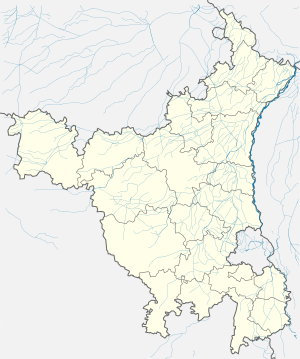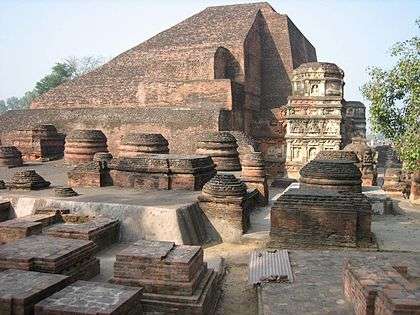Ghasera Fort
Ghasera Fort is a ruined fort in Ghasera village in Nuh district of Haryana state in northern India, which has been notified as a protected monument by the state government.[1] Currently, the majority of the residents of the village are Muslim Meos, though Hindus also live there.
Ghasera Fort | |
|---|---|
Ruined Fort | |
 Ghasera Fort  Ghasera Fort | |
| Coordinates: 28.1362471°N 77.0765927°E | |
| Country | |
| State | Haryana |
| District | Mewat district |
| Elevation | 199 m (653 ft) |
| Demonym(s) | Mewati |
| Languages | |
| Time zone | UTC+5:30 (IST) |
| ISO 3166 code | IN-HR |
| Vehicle registration | HR |
| http://www.mewat.gov.in | |
History
The ruined Ghasera Fort lies at Ghasera village 14 kilometres (8.7 mi) from Nuh city on Nun-Sohna highway. In 18th century, Ghasera was ruled by Bargurjar Rajputs whose territory included the parganas of Ghasera, Indor, Kotla, and Sohna. To their north was the Princely State of Nawabs of Farrukhnagar which was founded in 1732. To their west was the jagir of Ahir Rao's of Rewari (ancestors of Rao Tula Ram) with forts at Gokulgarh and Guraora. In the south were the ruler of Jats of Bharatpur State, and Kachwaha Rajput rulers of Alwar State. Mughal, who were protected by Marathas, had their territory shrunk to a nominal area from Delhi to Palam.
In 1750 after Jat king Surajmal defeated Moghuls. he forced them to sign a treaty according to which Moghuls agreed to pay a large fee as war compensation and promised not to desecrate Hindu temples in Jat territory.[2] In 1753, Surajmal killed "Rajput raja Bahadur Singh Bargujar" and his son "Ajit Singh" of "Koil" ("Chakala Koil" or present day "Aligarh" on outskirts of Palwal) in the "Battle of Ghasera" and captured the Ghasera fort.[2][3]
During the "1753 Battle of Ghasera", the Jats laid siege to Ghasera, which lasted for 3 months.[3] The Raos of Rewari, led by Bhawani Singh, who were traditional enemies of Bargurjar of Ghasera fought on the side of Jats.[3] During the siege, 15000 jats and their allies were killed by the gun fire from ramparts of Ghasera fort. On 23 April 1753, a desperate Bahadur Singh Bargurjar slayed all his women, opened the gates of the fort for the final battle to death during which he and his companions were killed.[3]
After Ghasera, Jats once again turned to attack Delhi and they sacked Mughal capital in 1754, which resulted in Mughals pleading help from marathas.[2] Marathas and Mughals laid siege of the Jat fort of Kumher.[2] During the Maratha siege of Jats, the Mughal Imad-ul-Mulk assisted Bahadur Singh Bargujar's surviving son Fateh Singh Bargujar to recover Ghasera from Jats in January 1754, but a contingent of Suraj Mal's son Jawahar Singh ousted Fateh Singh Bargujar from Ghasera.[4][3] Maratha siege of Jats ended in peace treaty in 1754 between Jats and Maratha Peshwa Malharrao Holkar, facilitated by the Maratha ruler of Gwalior State Mahadaji Scindia with the help of Martaha Peshwa Malharrao Holkar's brother Raghunathrao.[2][5]
Architecture
Ruined walls and a grand entrance in stone and lakhori bricks built with surkhi (crushed baked red bricked)-lime mortar show that Ghasera was a historical village.[1] Of the four entrances, only one remains.[5]
See also
- List of Monuments of National Importance in Haryana
- State Protected Monuments in Haryana
- List of Indus Valley Civilization sites in Haryana, Punjab, Rajasthan, Gujarat, India & Pakistan
- National Parks & Wildlife Sanctuaries of Haryana
- List of Indian states and territories by highest point
- Tourism in Haryana
- Haryana Tourism
References
- Haryana to take 5 monuments in Nuh under State protection, Daily Pioneer, 23 June 2018.
- Jat Kingdom of Bharatpur
- Major General S. D. S. Yadava, 2006 Followers of Krishna: Yadavas of India, Lancer Publishers, page 51-52.
- Raj Pal Singh, 1988, Rise of the Jat power, Page 245.
- Photos: 71 years after independence, Gandhi Gram Ghasera battles neglect, Hindustan Times, 1 October 2018, page 2,7.
